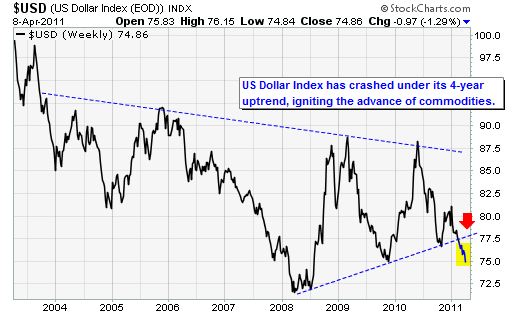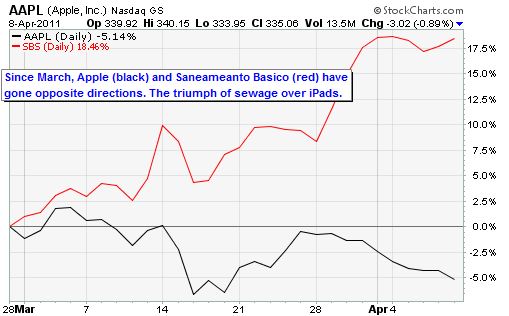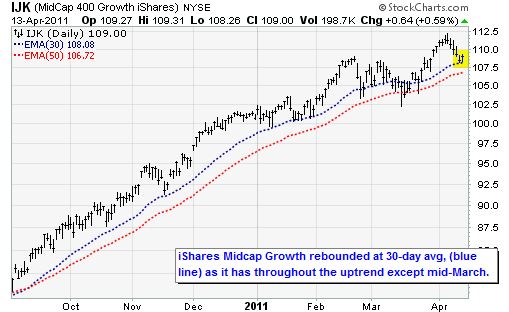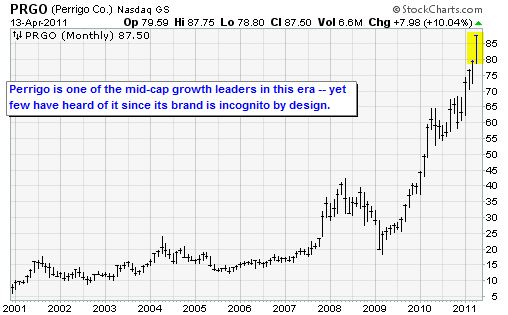What Slow Economic Growth and High Inflation Means for Stocks
Stock-Markets / Stock Markets 2011 Apr 18, 2011 - 04:05 AM GMTBy: Money_Morning
 Jon D. Markman writes: With slow economic growth and high inflation looming on the economic horizon, investors turn to earnings reports for a clue as to whether their favorite companies can handle what's ahead.
Jon D. Markman writes: With slow economic growth and high inflation looming on the economic horizon, investors turn to earnings reports for a clue as to whether their favorite companies can handle what's ahead.
First-quarter earnings season started with a bang this week with reports from major technology, basic materials and financial companies that mostly underwhelmed the crowd. The major averages closed the week right about where they started after rallying from a sizeable dip in the middle.
Alcoa Inc. (NYSE: AA) kicked off the festivities by beating earnings estimates for the fourth straight quarter. Investors didn't care for its underwhelming sales growth, and kicked a dent in the side of the aluminum giant.
Then JPMorgan Chase & Co. (NYSE: JPM) topped estimates, but traded down as bank investors worried about an increase in regulation that will trim revenue growth in coming quarters, and financials traded 2% lower for the week.
Google Inc. (Nasdaq: GOOG) was blasted after posting earnings in line with consensus, but then telling investors it planned to go on a hiring spree, and didn't care about the costs. The company's new chief executive officer Larry Page ticked off investors by muttering just a couple of sentences on the conference call and then hanging up. Shares fell 8.2% for the week, taking the tech sector down 1.1%.
All in all, the 33 Standard & Poor's 500 companies that reported so far have posted 38% year-over-year earnings gains on 7.3% year-over-year revenue gains. That means most of the income has come from cutting expenses and financial engineering, which worries people because it is unsustainable.
Energy stocks fell the most, down 3.1%, as crude oil prices sank the same amount to a still highly elevated $109.45 a barrel. The group is still the best of the year, with a 13.1% gain.
And on the economic front, the most important news was that core inflation remains very subdued, wages are declining, and initial jobless claims were up 27,000 to 412,000, almost 30,000 over consensus.
So what was going on behind the scenes? Financial news people will tell you that there was a reason for the big decline in the middle of the week. They'll point to renewed fears of a sovereign debt crisis in Europe, higher crude oil prices, and fears that chastened bulls would have to send out a search party to find any executives atGoogle who really care about hitting profit targets.
Yet the reality is that markets during options expiration week often seem to act according to rules set by in-patients at a manic-depressive clinic. There is so much money at stake in certain index and stock options, that you will see a lot of very strange behavior as the investment banks try to weasel out of paying off on wrong-way positions and hedge fund jockeys try to nudge winning trades deeper into the black with blatant, last-minute nudges.
Never believe anything you see in options expiration week, and particularly the last two days. It is a very artificial period. Buying interest looks a little more intense under the hood than it appears on the surface. Yet for the most part bulls and bears are locked in a stalemate. Current shareholders are mildly optimistic and not willing to part with their stocks. Yet bulls are not highly motivated to add new positions.
So what will come along next is some sort of negative surprise that will make holders more anxious to sell their stocks to lock in profits, or a positive surprise that will make bystanders decide they need to get in on this action. The statistical history of the market suggests that in similar situations -- when six or seven straight days of selling conclude with a flat spot just ahead of the earnings season -- the resolution has tended to be to the upside.
Dollar Daze
The big story of the past two weeks has been the renewed crash of the U.S. dollar and the rise of commodities, as gold and silver jumped more than 12%. The buck hit a new three-year low against a basket of currencies.
Most of the torpor in equities stemmed from the fact that they had jumped 7% in late March and early April not long after bears cynically thought they finally got the break they needed, with an earthquake and tsunami in Japan to top off turmoil in the Middle East and a worsening debt crisis in Europe.

As we head into the second quarter, it's clear that global growth is decelerating from a relatively high level, led by China, Japan, the United Kingdom and the periphery of Europe.
Commodity inflation and the continuing depression in U.S. real estate has led most credible economists to shave down their U.S. growth prospects, too. Inventory restocking, which was a huge boost to growth coming out of the last recession, is over. Estimate revisions across Asia have declined into a neutral zone, and the earnings estimate momentum of the United States is also tipping lower.
One of the most important factors on the world stage over the next year will be Japanese rebuilding. That will be inflationary due to the extreme levels of quantitative easing exercised by the Bank of Japan, which devalues the yen and then kicks off a chain reaction among other currencies to devalue as well. This is one reason why the dollar has been so weak.
Commodity inflation -- higher corn, cotton, crude oil, and precious metals prices -- has become structural rather than cyclical, which means that it is likely to be "sticky" even as economic growth slows. Yet as global growth slows it is likely to have a dampening effect on commodity prices as well, preventing investors in "stuff" to be disappointed if they have really grandiose plans.
If growth slows and cyclical violence and unrest in the Middle East and North Africa wane, crude oil prices will most likely stabilize at a high level after creating "demand destruction" in the United States and Europe. In plainer English, oil prices can rise only to the extent that people are willing to pay $4 per gallon or more at the gas pump in the United States; we saw in 2008 that ultimately they begin to use less, conserve more, and demand falters.
In this environment, the bullish tone of the stock market can continue, but traditional high-beta stocks -- techs and consumer discretionary -- will peak. We are already seeing that in former tech momentum names like Apple Inc. (Nasdaq: AAPL),Amazon.com (Nasdaq: AMZN),F5 NetworksInc. (Nasdaq: FFIV),Google, NetApp Inc. (Nasdaq: NTAP) andBroadcom Corp. (Nasdaq: BRCM), as well asNike Inc. (NYSE: NKE) andUrban Outfitters Inc. (Nasdaq: URBN). Some high-beta stocks do remain -- names likeLululemon Athletica Inc. (Nasdaq: LULU) andChipotle MexicanGrill Inc. (NYSE: CMG) -- but they may have just been left to turn out the lights.

Now the momentum is shifting to more sedate groups such as utilities likeCalpine Corp. (NYSE: CPN) and Companhia de Saneamento Basico(NYSE ADR: SBS); high-yield energy producers likeBaytex Energy Corp. (NYSE: BTE) andMarkWest Energy Partners LP (NYSE: MWE); and niche companies with proven plans likeBalchem Corp. (Nasdaq: BCPC) andViacom Inc. (NYSE: VIA).
One way to think about the phase that is likely to come next is that "price makers" will triumph over "price takers," as commodity inflation either erodes margins or makes it more difficult to increase margins. Some examples of price makers are reinsurers (which were bombed in a knee-jerk reaction to the tsunami, but have recovered because they can name their own prices), and healthcare services (because of the erosion of Obamacare drag on health-care profits).
Another group that can perform well in an environment like this is growth stocks that have the least sensitivity to inflation. Remember that value tends to outperform in the initial recovery from a recession (2009), but growth then takes the baton for most of the economic cycle thereafter.
The next two weeks will set the tone for the rest of the first half, and perhaps the rest of the year. My RiskTaker, YieldSeeker and StrataGem XR lists should continue to represent the best positions available, and the monthly StrataGem portfolio will just do its thing -- determining the sectors and stocks with the most growth potential on a month-by-month basis.
Bottom line: Expect decelerating global growth as the United States pulls back on quantitative easing and fiscal spending; more inflation; improvements in commodities; and along the growth/value axis, a focus on above-average growers that can set prices.
Mid-Cap Madness
So what stocks are making new highs in this environment? I have been recommending one of them for more than a year: over-the-counter medicine makerPerrigo Co. (Nasdaq: PRGO), which shot up another 5%. You know you're still in a bull market when a mid-cap growth stock like PRGO can fly. In a truly bearish phase, such as last June, nothing escapes the gravity of selling.

More evidence of stabilization can be seen in theiShares S&P MidCap 400 Growth (NYSE: IJK) fund, the largest holding in my newsletter's RiskTaker portfolio. Throughout the eight-month uptrend since the summer, IJK has slipped to its 30-day average numerous times for a rest stop. That's where it found solid ground on Wednesday, as shown above. The only time when it fell a little more was in the few days around the Japanese earthquake/tsunami catastrophe in mid-March, and even then it recovered quickly. It could go there again in any further mid-April weakness; the level is $106.70.
Remember that the neat thing about focusing on mid-cap growth is that you don't have to make a bet on a sector, since there are all sectors included. And you don't have to make a big bet on small companies vs. large companies, which is the traditional axis that divides the investment universe. All you need to do is bet that you are in an environment when credit is available, growth opportunities are plentiful, and neither consumers nor businesses are completely strapped.

These are the environments in which the smartest executives gravitate toward chances to run mid-sized companies that are nimble enough to dodge bullets but large enough to enjoy economies of scale. That is scenario for a company like Perrigo, which makes remedies that look and act like Sudafed or Advil but are sold under the name of a drug store, such as CVS, at half the price of the famous brand.
Other strong IJK fund leaders are affinity card service providerAlliance Data Systems Corp. (NYSE: ADS); warehouse ownerAMB Property Corp. (NYSE: AMB), Brown & Brown Inc. (NYSE: BRO),Clean Harbors Inc. (NYSE: CLH),Chipotle Mexican Grill Inc. (NYSE: CMG) and Deckers Outdoor Corp. (Nasdaq: DECK). Check out those charts, and you'll see why the index is so strong. Stick with IJK as a major holding, and add on.
The Week Ahead
The main focus in equity markets will be earnings. But in economic data, housing data will take the stage during the first and middle parts of the week. Then we'll get jobless claims on Thursday and a read on manufacturing from the Philly Fed survey. Markets are closed Friday for observance of Good Friday.
Monday: No economic releases planned
Tuesday: Housing starts.
Wednesday: Existing home sales
Thursday: Initial jobless claims
[Editor's Note: Money Morning Contributing Writer Jon D. Markman has a unique view of both the world economy and the global financial markets. With uncertainty the watchword and volatility the norm in today's markets, low-risk/high-profit investments will be tougher than ever to find.
It will take a seasoned guide to uncover those opportunities.
Markman is that guide.
In the face of what's been the toughest market for investors since the Great Depression, it's time to sweep away the uncertainty and eradicate the worry. That's why investors subscribe to Markman's Strategic Advantage newsletter every week: He can see opportunity when other investors are blinded by worry.
Subscribe to Strategic Advantage and hire Markman to be your guide. For more information, please click here.]
Source : http://moneymorning.com/2011/04/18/...
Money Morning/The Money Map Report
©2011 Monument Street Publishing. All Rights Reserved. Protected by copyright laws of the United States and international treaties. Any reproduction, copying, or redistribution (electronic or otherwise, including on the world wide web), of content from this website, in whole or in part, is strictly prohibited without the express written permission of Monument Street Publishing. 105 West Monument Street, Baltimore MD 21201, Email: customerservice@moneymorning.com
Disclaimer: Nothing published by Money Morning should be considered personalized investment advice. Although our employees may answer your general customer service questions, they are not licensed under securities laws to address your particular investment situation. No communication by our employees to you should be deemed as personalized investent advice. We expressly forbid our writers from having a financial interest in any security recommended to our readers. All of our employees and agents must wait 24 hours after on-line publication, or 72 hours after the mailing of printed-only publication prior to following an initial recommendation. Any investments recommended by Money Morning should be made only after consulting with your investment advisor and only after reviewing the prospectus or financial statements of the company.
Money Morning Archive |
© 2005-2022 http://www.MarketOracle.co.uk - The Market Oracle is a FREE Daily Financial Markets Analysis & Forecasting online publication.



